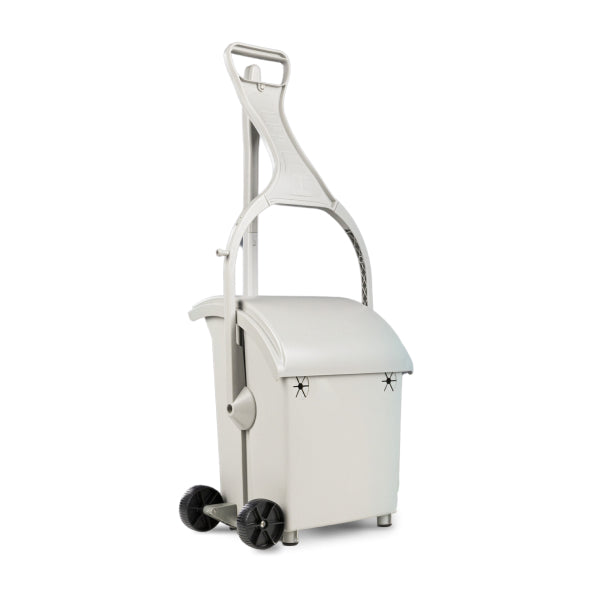You probably agree that a dog is not just a pet but a family member. Said that, you’ll want to make sure that your canine housemate is living a happy and healthy life. It includes keeping an eye out for parasites in dogs. These unwanted guests crawl into your dog's skin, ears, and insides, causing problems that range from mild to severe.
While some types of parasites aren’t life-threatening, others - especially heartworms - can be. Puppies and smaller dogs are particularly vulnerable to these. This article covers all you need to know about the subject matter. You’ll learn how to prevent and treat dog parasites and ensure that Fido lives a parasite-free life. Read on to learn everything there is to know about internal parasites in dogs, external parasites in dogs, and how to get rid of them.
Symptoms of Parasites in Dogs
Internal Parasites in Dogs
Intestinal Parasites in Dogs
Intestinal parasites in dogs are the most common. They’re easy to catch and, in most cases, easy to treat. A simple walk around the neighborhood can expose your pup to different intestinal parasites. They can easily enter a dog’s body through contaminated food or water and contaminated feces (that’s precisely why you shouldn’t let your dog lick or eat anything while on a walk). Fido may also get these parasites by contacting an infected dog or licking a contaminated object.
Pups can even get certain worms through their mother’s milk or inside the womb. How can you know if there are parasites in your dog’s intestine? Diarrhea, loose or bloody stool, noticeable weight loss, and, of course, visible worms in the stool can all be signs that foreign entities have entered your dog’s system.
The most common parasites that might infect your four-legged friend are roundworms, hookworms, whipworms, and tapeworms. Keep in mind that these parasites might end up in your dog’s feces and go on to infect other dogs.
Blood Parasites in Dogs
Blood parasites in dogs, scientifically known as Haemocanis Mycoplasma, are a type of parasite that enters a dog’s body through fleas and ticks. This harmful parasite attacks Fido’s red blood cells, which carry the oxygen in its body. The M. Haemocanis has no cell walls, making it challenging to counter-attack. Of all the internal parasites in dogs, this is one of the most difficult to treat - especially in dogs who’ve previously had splenectomy, considering that the spleen is the organ that filters the damaged blood cells.
A puppy infected with M. Haemocanis will show signs of tiredness, loss of appetite, depression, fever, and white-ish or purple-ish gums. If you notice any of these symptoms, it’s safe to assume that there are parasites in your dog. The best course of action here is to get veterinary help. A vet will introduce antibiotics and glucocorticoids into your pup’s body.
You can also expect hospitalization and steroid therapy in some cases. It’s worth mentioning that - even after treatment and recovery - your dog might continue being a carrier of the disease. With that in mind, prevention is better than the cure.
Brain Parasites in Dogs
Without proper treatment, brain parasites in dogs can be dangerous. Parasites can easily and quickly spread to the central nervous system. There are different types of brain parasites in dogs, including but not limited to Taenia, Dirofilaria immitis, B. Columnaris, and Toxocara Canis. These parasites enter your dog's system through the nasal cavity and the ears, any open wounds, and through stagnant water if swallowed.
Luckily, the symptoms of brain parasites in dogs are very loud and clear. You may notice signs of depression, staggering, head tilting, walking in circles, head pressing, dizziness, and weak muscle movement in the face. If you notice these signs, contact the vet immediately for quick action.
The earlier you notice the signs, the better. That is because mild cases are more accessible with medications and anti-seizure drugs, while more advanced cases might be more complicated. So act quickly, and be ready to take your dog to several checkups post-treatment.

Lung Parasites in Dogs
Another common type of parasite in dogs are lung parasites, known as lungworms. Lung parasites in dogs infect Fido once it ingests lungworm eggs or immature lungworm larvae. Mama dogs can pass the larvae on to their puppies as well through nursing and grooming.
Lungworms come in two primary forms: roundworms and flukes. They enter the gastrointestinal tract as larvae, break through the intestinal wall, and go to the lungs through the circulation system. If lungworms find a way into Fido’s lungs, you’ll notice your pup having difficulty breathing. You’ll also see fast panting, mucus-free coughing, and exercise intolerance.
The good news is that it’s pretty easy to get rid of these parasites in dogs, especially if you notice the symptoms early on. A vet will advise you to administer dewormers orally for two weeks or more, depending on how severe the case is and what type of worm you’re dealing with. The dead worms in the lungs may cause inflammation, so the vet will probably prescribe some anti-inflammatory meds.
Heart Parasites in Dogs
Heartworms, or heart parasites in dogs, are among the most dangerous parasites that can infect your canine companion. They are foot-long worms that cause severe damage to the heart, lungs, and other organs in your pet’s body. Unfortunately, dogs tend to be good hosts for heartworms, allowing them to grow into adulthood, reproduce, and multiply inside your pup's organs.
If left untreated, a dog can harbor these parasites en masse, which in turn will cause its health to crumble real quickly. Even after treatment, the result and damage caused by heartworms can have an everlasting effect on your furry friend’s organs. That said, prevention is the best medicine for this particular type of dog parasite.
In the early stages, symptoms of heart parasites in dogs are few. But as the condition advances, signs will show up one after the other and will get more severe by the day. You might notice a persistent cough, fatigue after minimal exercise, and loss of appetite. Later stages of the condition include a swollen belly due to excess fluid in the abdomen and sudden blockages of blood flow, potentially leading to cardiovascular failure.
Here, you’ll notice pale gums and blood-colored or dark-brown urine. If the parasites get to this phase, the vet must surgically remove them immediately.
As serious as heartworms may be, noticing the signs early on can help your dog have a high chance of recovery. Proper treatment involves stabilizing your dog’s condition and limiting its exercise levels before administering the right medications to eliminate the creepy crawlies.
External Parasites in Dogs
Skin Parasites in Dogs
Watching your dog enter an itching frenzy and a never-ending scratching cycle can be unnerving. The cause is almost always skin parasites in dogs. These dog parasites often come in the form of fleas, ticks, and mange mites, which gladly infest your dog's body.
It is no surprise that these are the most common parasites in dogs; a dog can easily transmit them to another or through objects like rugs, beds, sofas, and soft toys. What makes skin parasites in dogs a pain to eliminate is that they spread quickly and multiply fast.
As for symptoms, the most noticeable would be excessive itching and scratching - followed by hair loss, tiredness, pale gums, and skin redness.
If you notice any of these symptoms, check with a vet. That’s because even though ticks are easily detectable with the human eye, mites and fleas aren’t. You can generally treat flea infestations with preventive medications, and you’ll need to thoroughly clean your house, including any soft surfaces your four-legged friend enjoys lounging on.
When it comes to mites, you can get rid of them using oral meds. Ticks, on the other hand, can be physically removed. The vet may also prescribe medication to help with the annoying itch.
Parasites in Dogs' Ears
Another common form of external parasites in dogs is parasites in dog's ears, known also as ear mites. These microscopic parasites cause extreme itchiness in and around your dog’s ears. You’ll notice a lot of ear scratching and head shaking, alerting you of a problem you must deal with as soon as possible. Your dog can pick up ear mites from other pets and their surroundings.
If you don’t notice the symptoms early on, your dog might start frantically scratching its ears, causing bleeding sores. The excessive shaking of the head, as well, might result in pockets of blood in the ear flap. You might also notice black or brown discharge oozing from your pup's ears, in addition to foul odor. It points toward secondary infections. Figuring out how to treat parasites in a dog’s ears highly depends on how far the infestation has come. It usually involves cleaning the ear as well as some medications. Your dog will make it evident that it has external parasites. All you need to do is read the signs.
How to Get Rid of Parasites in Dogs
How to treat parasites in dogs is a very general question, as it doesn’t go deep into the specifics - especially since each parasite differs from the other, and the treatment varies accordingly. For example, knowing how to get rid of intestinal parasites in dogs involves different methods from those heartworms.
You can treat most intestinal parasites with oral medication, but that, of course, depends on the severity of the case and the stage the condition is in. With blood parasites, you’ll look into antibiotics and, in more severe cases, steroid therapy and hospitalization. In brain parasites, medications, and anti-seizure drugs are used to treat mild cases, while more advanced cases would be challenging.
Lungworms, on the other hand, are some of the easiest parasites in dogs to treat - especially those in the early stages. The deworming medication works pretty much in all cases of lungworms, but you may need some anti-inflammatories as well. Should your dog’s heart become home to heartworms, you’ll first need to restrict its exercise and stabilize its condition. It will prepare it for the proper medication. Certain cases may require the vet to remove the heartworms surgically.
External parasites in dogs are easier to treat, but they just as easily spread through the house as well. Fleas and mites that latch onto your four-legged friend’s skin and hair, for example, require preventive medication. As for ticks, another form of skin parasite in dogs, you can remove them physically and treat the affected area with disinfectants.
Skin parasites in dogs will also require you to clean your house thoroughly and everywhere your dog has been on and around. Remember that these parasites will quickly move from one soft surface to another. Treating ear parasites, on the other hand, involves cleaning the ear and administering oral medications. As we said previously, this depends on how severe the case is. Long story short, the sooner you see the signs, the easier the treatment will be for you and Fido - no matter the type of parasite.
Finally, make sure to have your vet’s phone number saved on your mobile because the minute you see the first symptoms of parasites in dogs, you will want to call them. There’s no way around getting your dog checked since parasites are serious, and you want to treat them seriously.
Are Parasites in Dogs Contagious?
Our puppies are family members, and what hurts them hurts us, metaphorically and literally. It brings us to the question: are parasites in dogs contagious? As much as we’d like to say no, the answer is yes. In most cases, other dogs can pick up parasites in dogs through an infected dog's poop or contaminated soil. In some rare cases, certain worms can be contracted by humans, too.
Roundworms, hookworms, and tapeworms are zoonotic diseases and can be passed on to humans - especially the tiny ones - through close contact with dogs and contaminated stool or soil. That’s why preventive measures are vital. After all, prevention is cheaper, less tiring, and less nerve-wracking than treatment.
Read also: How to Choose the Right Dog Food: Best Dog Food Tips
To wrap up, parasites in dogs can range from easily treatable to more serious and - quite sadly - even fatal. We’re not saying this to make you panic. But it only shows how crucial it is to take preventive measures and pay extra attention to what your dog is trying to tell you through possible signs.
After all, even the most easily treatable parasite can become problematic if left untreated for too long. It pays to get familiar with everything Fido might encounter during its lifetime. It involves knowing how to prevent parasites early on, whether by maintaining your dog’s hygiene or paying attention to any symptoms. By taking all the proper measures, you can rest assured that your canine companion is parasite-free and full of glee.
















Leave a comment
This site is protected by hCaptcha and the hCaptcha Privacy Policy and Terms of Service apply.